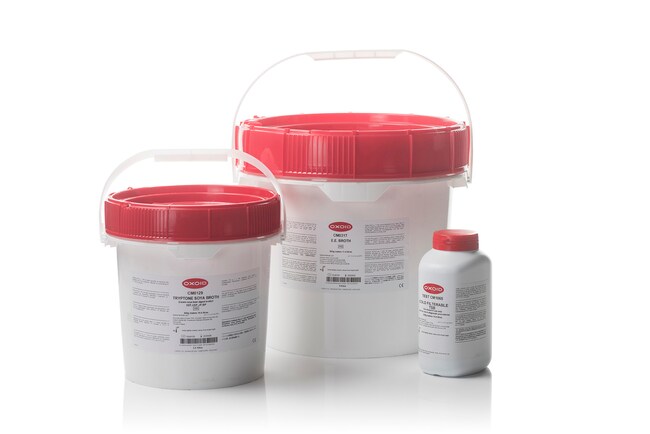Search Thermo Fisher Scientific
Brilliance™ Bacillus Cereus Agar Base (Dehydrated)

Brilliance™ Bacillus Cereus Agar Base (Dehydrated)
Isolate and differentiate Bacillus cereus from food samples with chromogenic Thermo Scientific™ Brilliance™ Bacillus Cereus Agar Base (Dehydrated).
BrillianceBacillus cereus Agar incorporates the chromogenic substrate 5-bromo-4-chloro-3-indolyl-ß-glucopyranoside, which is cleaved by the enzyme ß-glucosidase present in Bacillus cereus resulting in the formation of blue/green colonies. Combination of Polymixin B and Trimethoprim inhibit most Gram-positive bacteria and Gram-negative bacteria other than Bacillus cereus respectively.
| Description | Brilliance Bacillus Cereus Agar Base |
| Form | Powder |
| Product Type | Agar |
| Quantity | 500 g |
| Yield | For 12.2L medium |
| Unit Size | Each |
| Catalog Number | Specifications | Unit Size | Quantity | Price (USD) | |||||||||||||||||||||||||||||||||||||||||||||||||||||||||||||||||||||||||||||||||||||||||||||||||||||||||||
|---|---|---|---|---|---|---|---|---|---|---|---|---|---|---|---|---|---|---|---|---|---|---|---|---|---|---|---|---|---|---|---|---|---|---|---|---|---|---|---|---|---|---|---|---|---|---|---|---|---|---|---|---|---|---|---|---|---|---|---|---|---|---|---|---|---|---|---|---|---|---|---|---|---|---|---|---|---|---|---|---|---|---|---|---|---|---|---|---|---|---|---|---|---|---|---|---|---|---|---|---|---|---|---|---|---|---|---|---|---|---|---|
| CM1036B | Each | 500 g | Request A Quote | ||||||||||||||||||||||||||||||||||||||||||||||||||||||||||||||||||||||||||||||||||||||||||||||||||||||||||||
| |||||||||||||||||||||||||||||||||||||||||||||||||||||||||||||||||||||||||||||||||||||||||||||||||||||||||||||||
Bacillus cereus, a Gram-positive, aerobic, spore-forming rod-shaped bacterium, is widely distributed in nature. It is readily isolated from soil, dust, cereal crops, vegetation, animal hair, fresh water and sediments. Therefore, it is not surprising to find the organism associated with virtually every raw agricultural commodity.
The role of Bacillus cereus in food poisoning, particularly from the consumption of contaminated rice, is now well documented1,2,3. The organism has also been implicated in eye infections4,5 and a wide range of other conditions, including abscess formation, meningitis, septicemia, and wound infection.
- Easy-to-read: cleavage of the chromogenic substrate the enzyme ß-glucosidase present in Bacillus cereus results in the formation of blue/green colonies.
- Selective: a combination of Polymixin B and Trimethoprim make the medium selective for Bacillus cereus.
Brilliance Bacillus cereus Agar incorporates the chromogenic substrate 5-bromo-4-chloro-3-indolyl-ß-glucopyranoside, which is cleaved by the enzyme ß-glucosidase present in Bacillus cereus resulting in the formation of blue/green colonies. Polymixin B inhibits most Gram-negative organisms and some Gram-positive organisms including some Bacillus other than Bacillus cereus. Trimethoprim, which is also added to the medium, blocks folic acid synthesis necessary for DNA production and is active against many Gram-positive bacteria including Staphylococcus aureus, Enterococcus spp. and some non-cereus Bacillus species. The combination of these two antibiotics has been shown to be more effective than the use of polymyxin B alone3.
Because Bacillus thuringiensis is biochemically identical to Bacillus cereus, it will also grow as blue/green colonies on this medium. Bacillus thuringiensis is known primarily as an insect pathogen, but it has also been reported to have been linked to some human gastroenteritis outbreaks4.
Not all products are available for sale in all territories. Please inquire.
Remel™ and Oxoid™ products are now part of the Thermo Scientific brand.
1. Foodborne Pathogenic Microorganisms and Natural Toxins Handbook Bacillus cereus and other Bacillus spp. (2003) U.S. Food & Drug Administration (C.F.S.A.N)
2. The Oxoid Manual (1998) 8th Edition. Oxoid, UK.
3. Poster – Cloke, J. M., Ring, M., Campbell, S., Smith, E., and Stringer. J. Evaluation of a new Oxoid chromogenic medium for the Isolation of Bacillus cereus from foods. (2003) Oxoid & Burton’s Foods, UK.
4. Handbook of Culture Media for Food Microbiology (2003) Volume 37. Chapter 4. Media for Bacillus spp. and related genera relevant to foods. Edited by Corry, J. E. L., Curtis, G. D. W. and Baird, R. M. Publisher - Elsevier, Amsterdam.